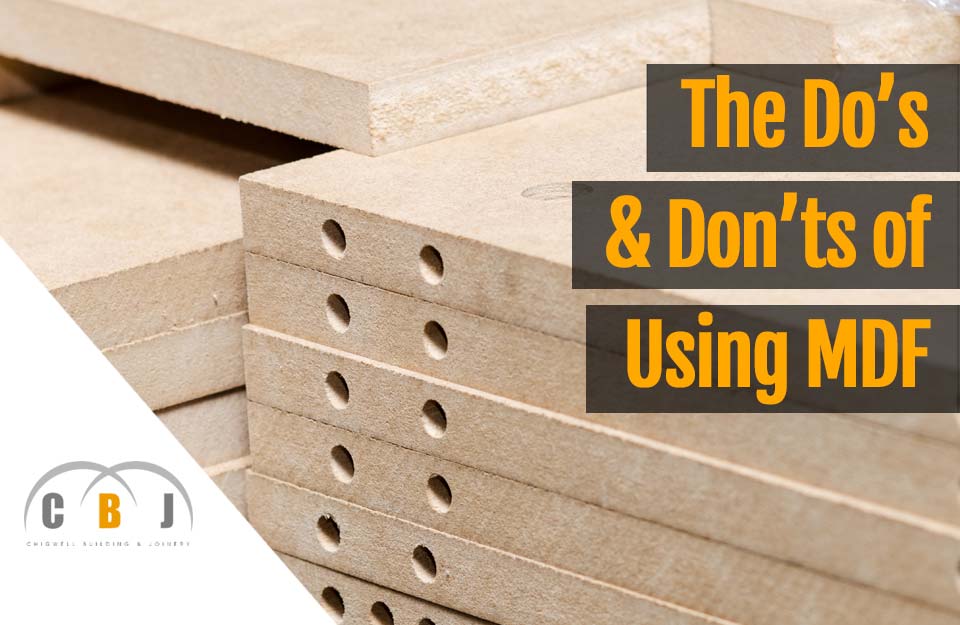News
The Do’s & Don’ts of Using MDF
Author Chigwell Building & Joinery
Date 04/10/2017
Get to Know This Highly Versatile Product
MDF is a superb building product because it’s relatively inexpensive, is a great choice for woodworking, is fairly adaptable and can be used for a variety of applications. But getting the best results from MDF is down to understanding the product and avoiding common mistakes. In this article we’ll take you through a number of classic do’s and don’ts when it comes to using medium density fibreboard.
What is MDF?
MDF (Medium Density Fibreboard) is a man-made product consisting of fine wood particles compressed together under intense pressure combined with resins and heat. To many unsuspecting individuals, MDF is most likely to be in every modern home in some way or another without them knowing. It is very commonly found in kitchen units, cabinets, shelves, furniture and many other everyday items yet is rarely seen in its raw form as it tends to be covered with a more attractive laminate or wood veneer.
As mentioned above, it’s very versatile but it does have it’s weaknesses as well as it’s strengths and is not suitable for all applications. Use it right and you can get amazing results. Use it or abuse it incorrectly and it will let you down.
Do Use It To Save Costs
The best and most obvious advantage to using MDF is the price. Compared to plywood or other solid wood sheets, MDF is a far better economic option. If you need to cover large areas with a paintable flat surface such as wall panelling or an inbuilt shelving system or media centre for example, you can mix and match materials. Use MDF where a solid flat surface is needed and then use timber for edging and stiffening. Once the whole thing is painted, you’ll never see the difference between where the MDF starts or where the wood trims begin.
If you plan to make something that requires a large amount of flat wood panels, save yourself a few pennies by substituting plywood or particleboard for MDF, which is just a good and will give a great finish.
Don’t Cut It Without a Mask
Cutting and milling MDF produces a lot of dust and fine particles which contains high levels of urea-formaldehyde due to the adhesive resins contained within the material. Wearing a mask is highly advised as the dust particles produced contain formaldehyde which is a know carcinogen.
If possible, always cut MDF in a well ventilated area and wear suitable masks to cover both your nose and mouth, as well as your eyes. The fine powdery dust produced from cutting MDF is very unpleasant and can cause asthma and other respiratory issues if inhaled. Get it in to your eyes and it can be very uncomfortable and itchy.
As well as protecting yourself, make sure you cover all necessary areas of your home from dust particles. MDF dust is very light and fine, so travels easily. Any cutting indoors will swiftly lead to dust spreading and settling throughout your home.
Do Drill Pilot Holes
It is not recommended that you use an electric screwdriver or impact driver with MDF without drilling a pilot hole and countersinking drill bit first, as any intense pressure or force will make it crumble and deteriorate. MDF appears as a solid, firm material on the surface but its compound is actually quite soft and flaky. It doesn’t take a great deal of pressure to cause it to split or break up, and when it does there’s no going back.
So avoid using nails and a hammer as any mishaps will most likely cause the surface to split and break up. And most certainly do not drop it as any heavy impact will destroy exposed edges.
Don’t Lift Large Sheets Alone
MDF might be an innocent looking material but it is deceptively heavy and a full sized sheet can weigh up to 100 lbs. Lugging one of those around can easily cause sprains, aches and pains so if you have an extra pair of hands, get help lifting them otherwise, opt for smaller manageable sheets to avoid injury.
Do Use a Primer
MDF is a superb material for painting but to get the very best results, always use a suitable primer first. The tops tend to always be nice and smooth but cut edges can look a little rough however if you prime it, then sand it and then prime it again, those rough edges can be made to look far better.
Then once fully primed, you are ready to paint it any colour you wish and you should get a far better, more even looking finish. The primer will act as a bond so that you get a consistent colour finish every time you paint.
Don’t Use It Outside
Never ever use MDF on projects that are intended to stay outdoors - it is simply not designed to be used in any wet weather. Even with priming and lots of waterproof painting, MDF will eventually lose the battle of the elements and deteriorate fast. Any water that gets near it will be absorbed like a sponge, leading to the MDF material swelling and eventually breaking up.
There are moisture resistant versions of MDF available on the market but overall, any project that requires a high level of water resistance should really be using a suitably treated timber or alternative product that is proven to deal with water far better.


